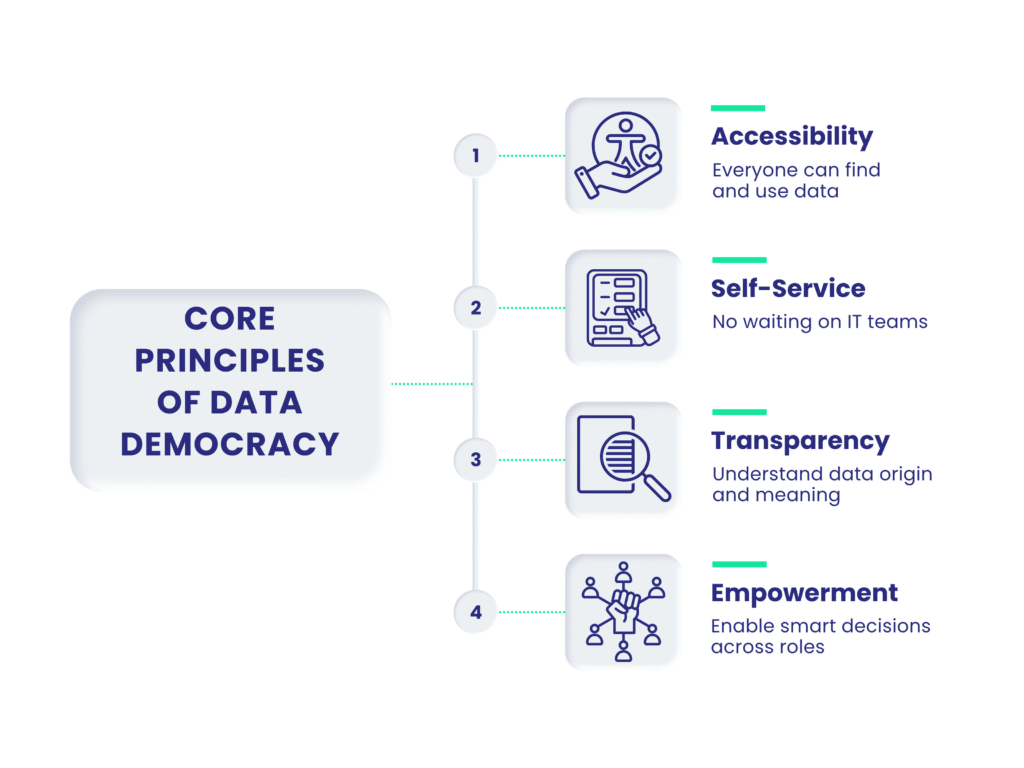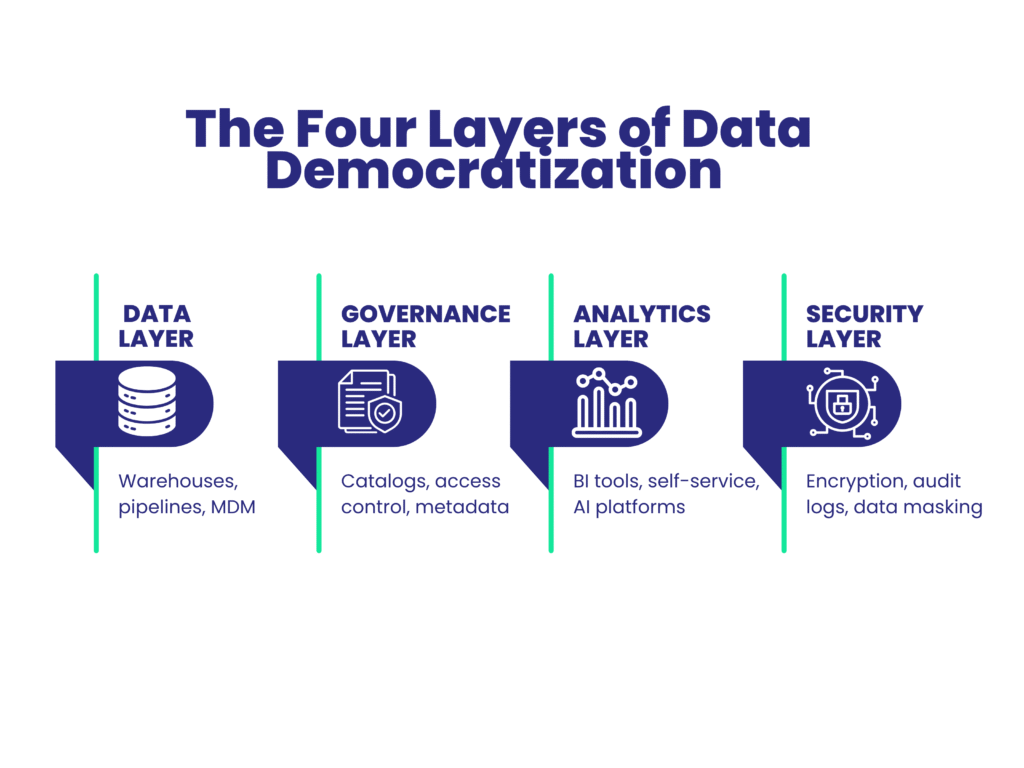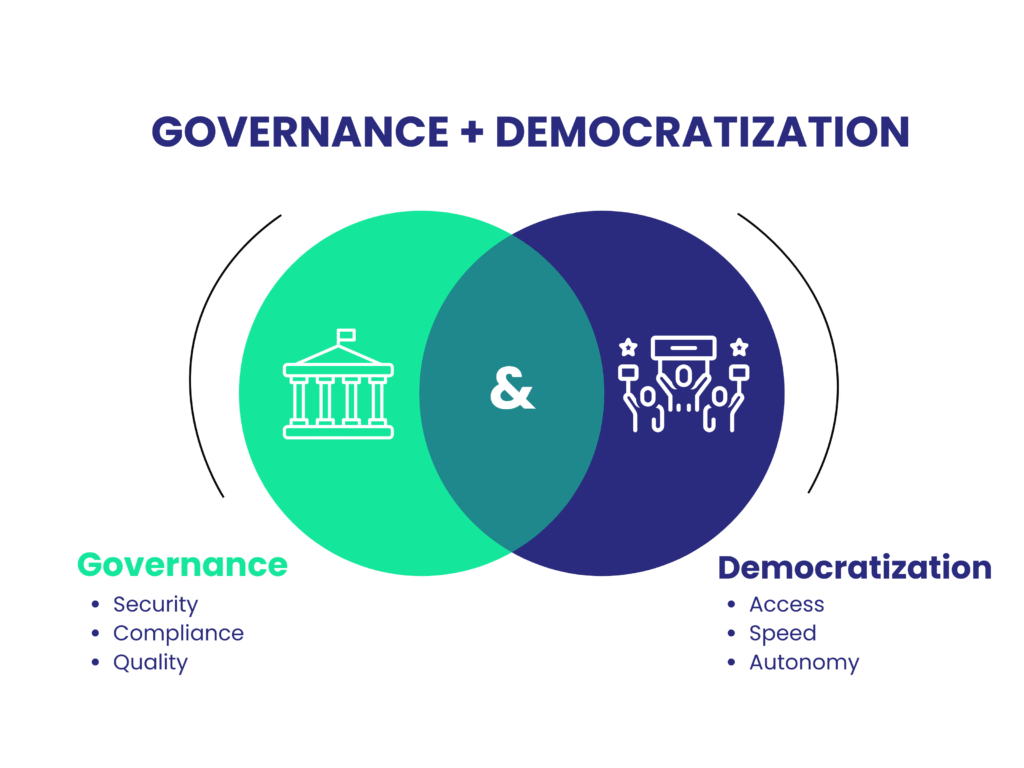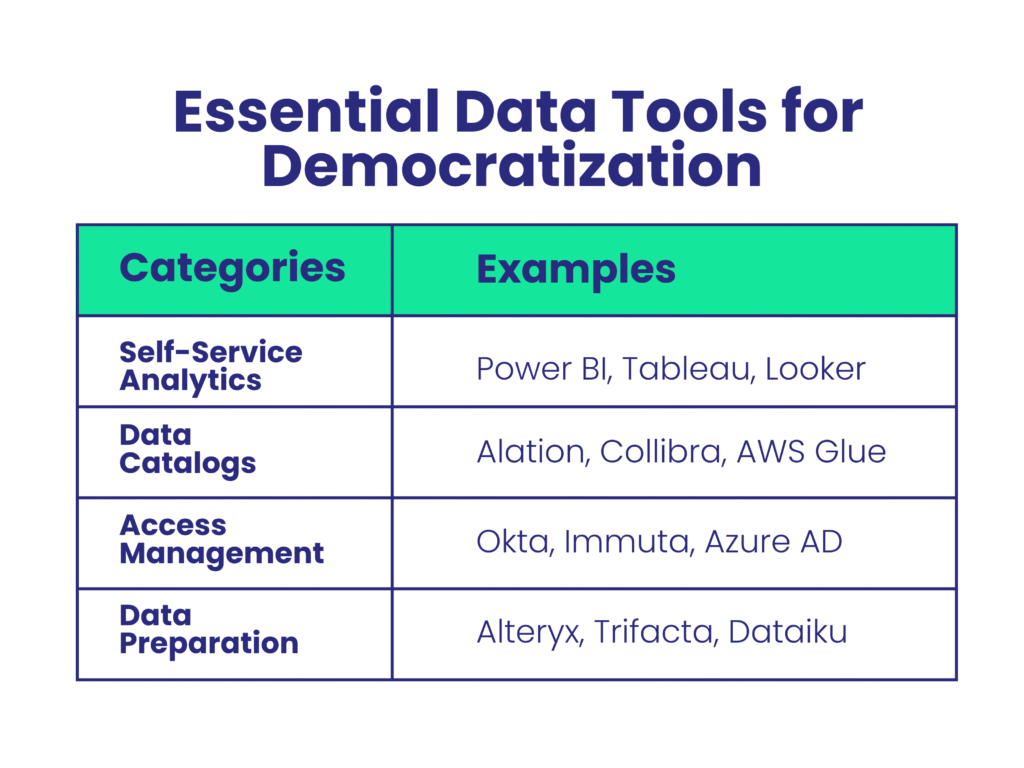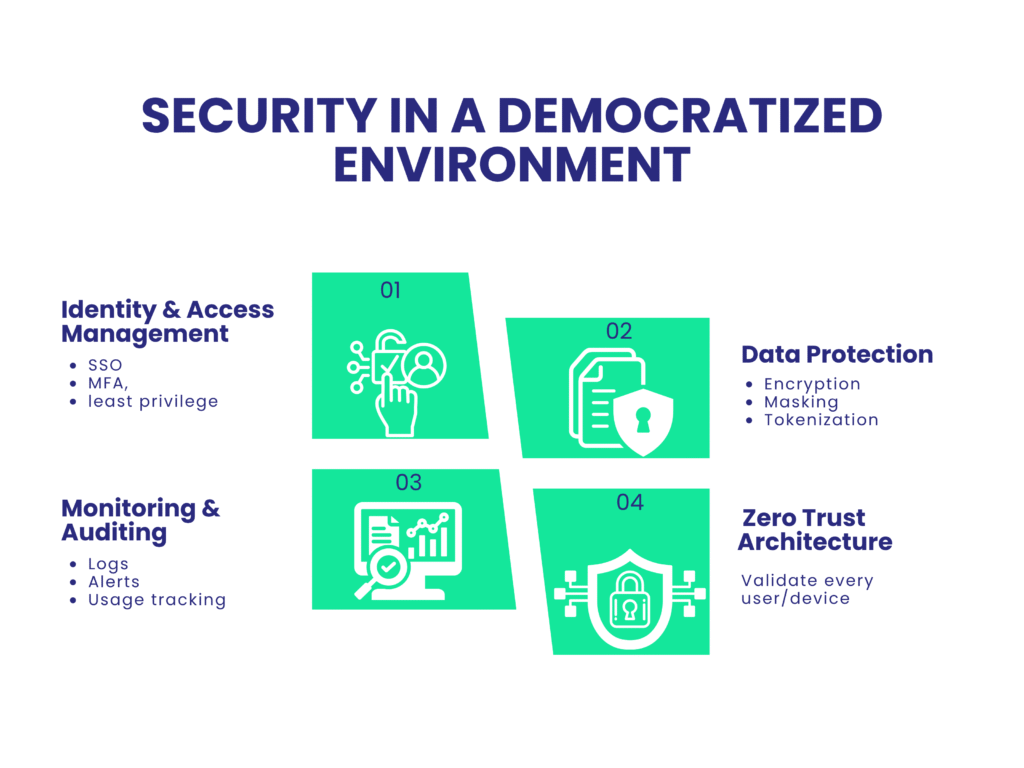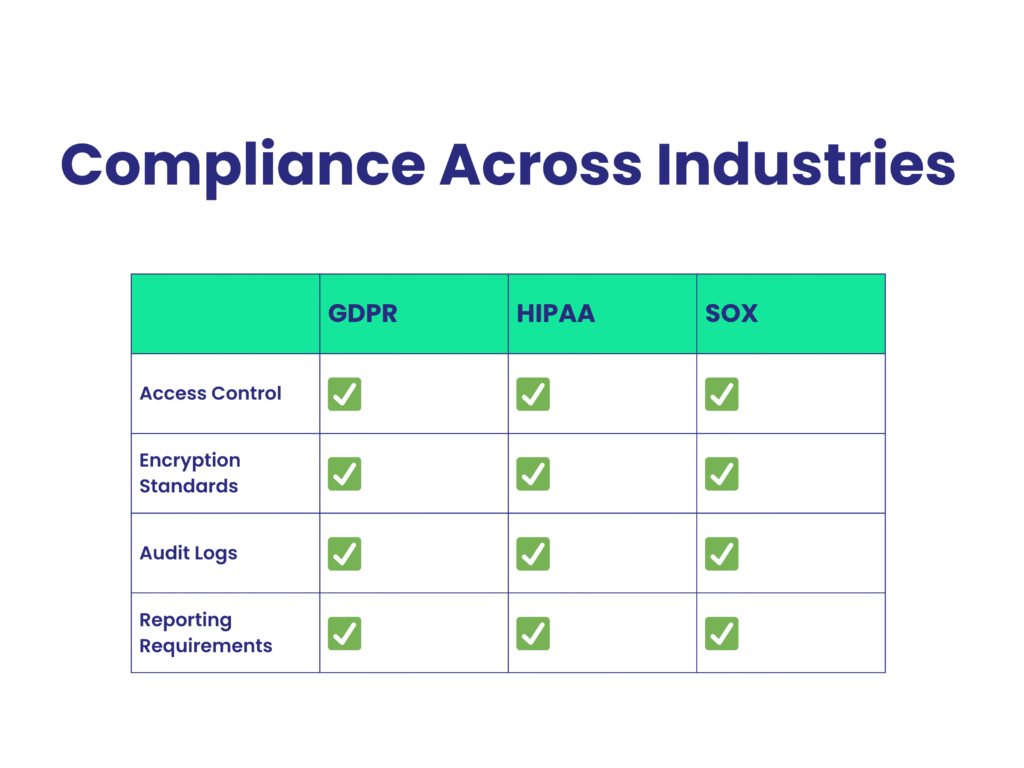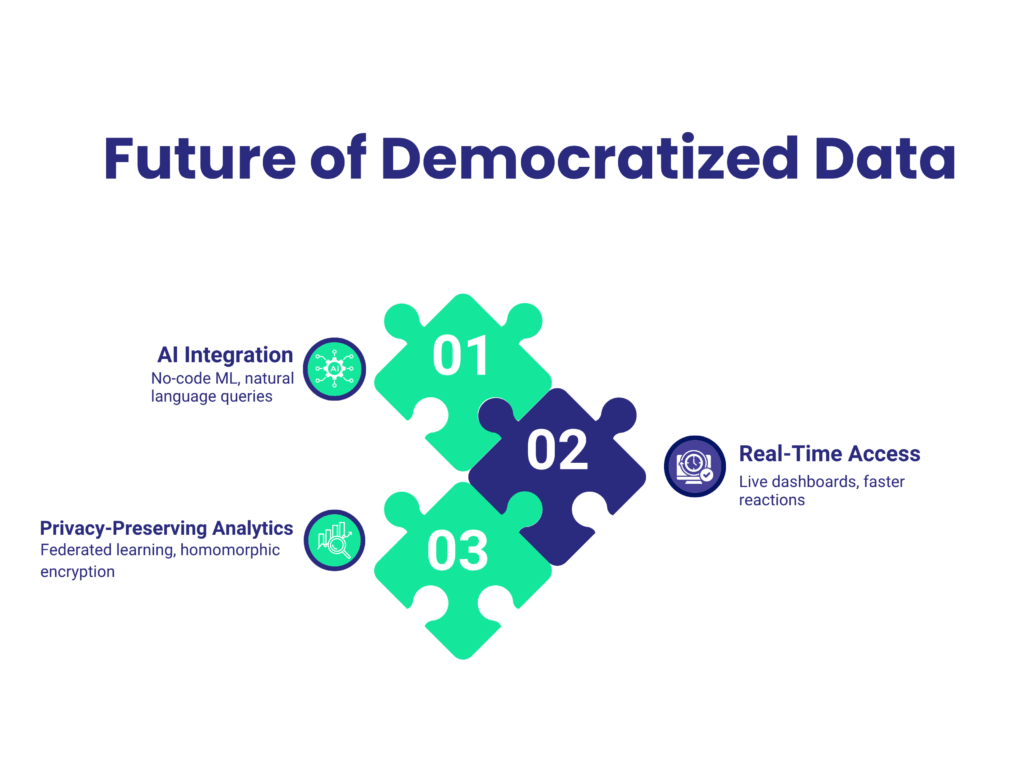In today’s data-driven world, organizations are sitting on goldmines of information. Yet, for many companies, this treasure remains locked away in silos, accessible only to a select few data specialists. The solution? Data democratization – the practice of making data accessible to all employees, regardless of their technical expertise.
But here’s the challenge: how do you open the data floodgates without drowning in security breaches or compliance violations? This comprehensive guide explores how to achieve true democratization of data while maintaining the highest standards of security and regulatory compliance.
What is Data Democratization?
Data democratization is the process of making data accessible to everyone in an organization, empowering non-technical users to find, understand, and use data for decision-making without requiring specialized technical skills or intermediaries.
Think of it as transforming your organization from a monarchy – where only the data nobles have access to information – to a democracy where every citizen can participate in data-driven decisions.
The Core Principles of Data Democracy
- Accessibility: Data should be easily discoverable and usable by all employees
- Self-service: Users can access and analyze data independently
- Transparency: Clear understanding of data sources, quality, and limitations
- Empowerment: Enabling informed decision-making at every organizational level
The Business Case for Information Democratization
Organizations that embrace democratized data typically see significant benefits:
Faster Decision-Making: When employees don’t need to wait for IT or data teams to pull reports, decisions happen in real-time.
Innovation Boost: More minds working with data means more opportunities for insights and breakthrough discoveries.
Improved Data Quality: When more people use data, quality issues are identified and resolved more quickly.
Enhanced Agility: Organizations can respond faster to market changes when everyone has access to relevant data.
Cost Reduction: Reduced dependency on specialized data teams for routine analysis tasks.
Understanding Data Democratization Architecture
A robust data democratization architecture serves as the foundation for secure and compliant data sharing. This architecture typically includes several key components:
Here’s an elaborated explanation of the four layers of a modern data stack in the context of data democratization, detailing each layer’s components and importance:
1. Data Layer:
This is the foundation of any data-driven architecture. It focuses on storing, organizing, and processing raw data from various sources.
Key Components:
- Data Warehouses and Data Lakes:
- Data Warehouses (like Snowflake, Redshift, BigQuery) store structured, curated data for analytics.
- Data Lakes (like AWS S3, Azure Data Lake) store raw, unstructured or semi-structured data at scale.
- These enable scalable storage and query performance.
- Data Pipelines:
- Tools like Apache Airflow, Fivetran, or Azure Data Factory automate data movement and transformation.
- They help ingest, clean, and transform data from source systems into formats ready for analysis.
- Master Data Management (MDM):
- Ensures a single source of truth for critical business entities (like customers, products).
- Maintains consistency and integrity of data across systems.
Why It Matters:
Without a robust data layer, analytics and AI efforts suffer from data silos, inconsistencies, and lack of scale. It enables data democratization by ensuring reliable and accessible data for everyone.
2. Governance Layer
This layer ensures that data is discoverable, understandable, and securely accessible, while complying with internal and external policies.
Key Components:
- Access Controls and Identity Management:
- Tools like Okta, Azure AD, and role-based access controls ensure only authorized users can access specific datasets.
- Promotes data security and compliance.
- Data Catalogs:
- Tools like Alation, Atlan, or Google Data Catalog provide a searchable inventory of available data assets.
- Help users discover and understand the data they need.
- Metadata Management:
- Captures information about the data—its origin, structure, usage, and quality.
- Adds context for users to interpret and trust the data.
Why It Matters:
Governance builds trust and accountability. It ensures democratization doesn’t lead to chaos, by putting structure around who can access what, and how data is documented and used.
3. Analytics Layer
This is the interface between data and the end-user, providing tools to extract insights, visualize trends, and make decisions.
Key Components:
- Self-Service Analytics Tools:
- Tools like Tableau, Power BI, Looker, or Qlik allow non-technical users to create dashboards and reports.
- They reduce reliance on central IT teams, enabling faster, decentralized decision-making.
- Business Intelligence (BI) Platforms:
- More advanced and collaborative environments for analyzing large volumes of data.
- Support scheduled reporting, alerting, and deeper exploration of trends and KPIs.
- Machine Learning Platforms (for Democratization of AI):
- Platforms like DataRobot, H2O.ai, Azure ML, or Google AutoML offer no-code/low-code environments.
- Allow business users to build predictive models without writing code, pushing AI usage beyond just data scientists.
Why It Matters:
This layer puts the power of data into the hands of business users. By enabling intuitive interfaces and AI tools, it accelerates the organization’s ability to extract value from data.
4. Security Layer
A crucial overlay across all other layers, this ensures that data is protected from breaches, misuse, and unauthorized access.
Key Components:
- Encryption at Rest and In Transit:
- Encrypts data stored in databases and data lakes (at rest), and during transmission across networks (in transit).
- Uses protocols like TLS and AES to ensure data confidentiality.
- Audit Logging and Monitoring:
- Tracks who accessed what data, when, and for what purpose.
- Helps detect suspicious activities and maintain regulatory compliance (e.g., GDPR, HIPAA).
- Data Masking and Anonymization:
- Hides or replaces sensitive data (e.g., PII) to protect user privacy while maintaining usability for analysis.
- Critical in environments where developers, analysts, or third parties work with production-like data.
Why It Matters:
Data democratization increases access—but without proper security, it increases risk too. A strong security layer ensures openness doesn’t compromise trust, privacy, or compliance.
Data Democratization and Data Governance: The Perfect Partnership
In today’s fast-moving digital economy, the ability to make data-driven decisions is a competitive necessity. Businesses across industries are seeking to empower their employees with faster access to data while maintaining strict compliance, quality, and security standards. This is where data democratization and data governance intersect—not as opposites, but as complementary forces that, when combined, unlock massive business value.
Why the Conflict Is a Myth
While some organizations mistakenly view data democratization as a threat to governance, the reality is quite the opposite. Democratization doesn’t mean anarchy—it means giving the right people access to the right data at the right time, under the right conditions.
- Democratization empowers business users, analysts, and teams to explore data and derive insights independently.
- Governance ensures this exploration happens responsibly—aligned with compliance rules, data quality standards, and security protocols.
Together, they form a scalable, secure, and compliant data culture.
The Governance Framework for Democratized Data
To operationalize this balance, organizations must establish a robust governance framework:
1. Data Stewardship
Designate data stewards within business units who are responsible for data integrity, access rights, and usage policies. They act as liaisons between technical teams and business users.
2. Policy Development
Develop policies that are understandable and actionable—clear enough to prevent misuse, but flexible enough to support innovation and exploration.
3. Quality Assurance
Automate data profiling and validation processes to ensure the data remains accurate, timely, and reliable, without introducing bottlenecks.
4. Compliance Monitoring
Implement systems that continuously monitor usage patterns and flag activities that may violate internal policies or external regulations.
Essential Data Democratization Tools
The right tools create the foundation for scalable and responsible democratization. Here’s a breakdown by category:
Self-Service Analytics
Empowers non-technical users to visualize and interpret data.
- Tableau, Power BI – Advanced dashboarding
- Looker, Qlik – Business Intelligence tools
- Databricks – Unified analytics platform for scalable insights
Data Catalogs
Helps users find, understand, and trust the data they use.
- Collibra, Alation – Enterprise-grade data cataloging
- Apache Atlas – Open-source metadata management
- AWS Glue – Serverless data catalog on the cloud
Access Management
Centralized control over user identity and access.
- Okta, Azure AD – Identity federation & SSO
- Privacera, Immuta – Dynamic access control for compliance
- Apache Ranger, Sentry – Policy enforcement tools
Data Preparation
Simplifies data wrangling and transformation for analytics.
- Alteryx, Trifacta – User-friendly data wrangling
- Dataiku – Collaboration for data teams
- Talend – Data integration and ETL pipelines
Security in a Democratized Data Environment
Security must be embedded from day one, not retrofitted. The best approach is multi-layered and based on zero trust principles.
1. Identity & Access Management (IAM)
- Use SSO to simplify and secure access
- Enable MFA for sensitive datasets
- Align access rights to job responsibilities
2. Data Protection
- Encrypt data in motion and at rest
- Use tokenization for PII
- Apply dynamic data masking to hide sensitive fields based on user roles
3. Monitoring & Auditing
- Track data usage in real-time
- Maintain comprehensive audit logs for compliance
- Set up alerts for unusual or suspicious activity
4. Zero Trust Architecture
- Validate every user, device, and session
- Enforce least privilege principles
- Reevaluate permissions continuously
Meeting Compliance Across Industries
Every industry has unique data obligations. A modern governance strategy must be adaptable to:
GDPR (EU Data Privacy)
- Automate data subject rights like deletion and portability
- Maintain full data lineage and auditability
- Enable full compliance reporting
HIPAA (Healthcare)
- Secure Protected Health Information (PHI)
- Implement strict access logs and authorizations
- Use encryption and integrity checks
SOX (Financial Reporting)
- Maintain audit trails for financial data
- Enforce segregation of duties
- Document change management workflows
The Future of Democratized Data
As data becomes increasingly important for every part of a business, the idea of data democratization—making data accessible to everyone, not just IT or data scientists—is evolving. The future will be shaped by three major trends:
1. Artificial Intelligence Integration
AI will become easier for non-technical people to use. This will happen through tools like:
- No-code/low-code ML platforms: These let users build machine learning models without writing code.
- Automated ML: Tools will automatically build and deploy models.
- Natural language interfaces: People can ask questions in plain English, and the system will pull insights from data (like talking to ChatGPT for your business data).
Why it matters: Business teams can make faster, smarter decisions without needing to rely on data teams for everything.
2. Real-Time Data Democracy
Data access won’t just be for reports made yesterday — it will be live and up-to-the-minute. This means:
- Instant decisions based on current data
- Real-time personalization, like showing the right product to the right user at the right moment
- Faster reaction to market shifts, such as changing pricing or inventory based on live trends
Why it matters: Businesses can stay ahead of the competition with faster, more relevant actions.
3. Privacy-Preserving Analytics
Sharing data is powerful, but protecting people’s privacy is critical. New methods will allow this balance, including:
- Differential privacy: Hides individual data while still allowing useful analysis.
- Federated learning: Models are trained across multiple devices or locations without centralizing data.
- Homomorphic encryption: Enables computation on encrypted data — meaning you can analyze it without ever seeing the raw data.
Why it matters: It builds trust while still unlocking data-driven innovation.
Conclusion: Your Path to Secure Data Democracy
Data democratization isn’t just a technology initiative – it’s a fundamental transformation in how organizations operate. When done right, it creates a competitive advantage that’s difficult to replicate.The key to success lies in recognizing that data democratization and data governance aren’t opposing forces, but complementary strategies that enable secure, compliant, and valuable information democratization. By following the principles and practices outlined in this guide, you can build a true data democracy that empowers your organization while protecting your most valuable asset – your data.
The future belongs to organizations that can harness the collective intelligence of their workforce through democratized data. The question isn’t whether you should democratize your data, but how quickly you can do it safely and effectively.
Ready to start your data democratization journey? Begin with a comprehensive assessment of your current data landscape and build from there. Remember, successful data democracy is a marathon, not a sprint.







